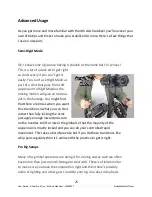
then it’s tightened too far and the cartridge is locking up which can
result in permanent damage to the the cartridge if used like that! The
correct setting of 0% or 100% damping needs to be backed off half a
turn from the point where the resistance begins to increase.
●
Finally check if the damping adjuster knob moves smoothly. If there’s
a lot of resistance or it feels a bit gritty than there’s a good chance
the nut on the other end is too tight. Get your socket and hold the
damping knob firmly and loosen it a quarter turn at a time until it
turns smoothly with no ‘grittiness’.
General Care
Here’s a few pointers that you should be aware of if you want to take best care of
your stabilizer.
Temperature range
You should keep your stabilizer under 80°C (180°F) as some of the polymers will
begin to soften after this point and potentially warp out of shape.
Don’t leave it in
a car on a hot day!
Think of it like any camera gear as you wouldn’t leave your
expensive camera gear in a hot car.
The minimum operating temperature is -10°C (14°F). This is due to the damping
gel hardening past this temperature and operating your stabilizer could do
damage to damping cartridge. Anecdotally, we’ve had customers use their
stabilizer at around -20°C (-4°F) in the snow but you would do so at your own risk.
Rain, Dust and moisture
You should avoid situations where the sealed bearings are subjected to water or
dust ingress. Your stabilizer can withstand light rain but heavy driving rain could
force water into the bearings.
Do not immerse your stabilizer in water!
29
User Guide - Glider Pro 3 Duo - 4th Axis Stabilizer - 20180917 ScottyMakesStuff.com


































